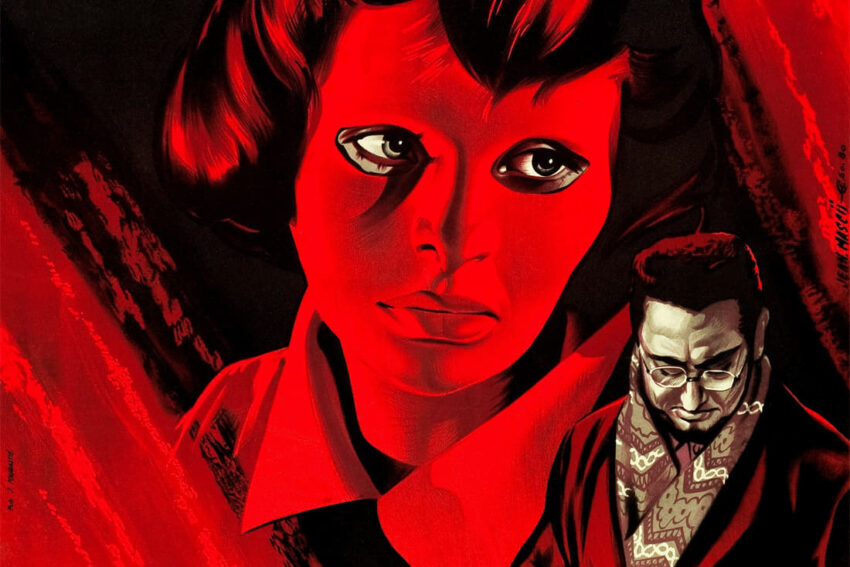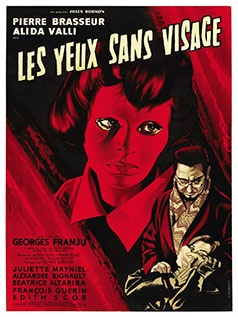
This is the first blog in our series on horror, Halloween, transplant and facial surgery. It explores the 1960 French-language horror film Les yeux sans visage or Eyes Without a Face, directed by Georges Franju. Based on the novel of the same name by Jean Redon, it revolves around a plastic surgeon who is determined to perform a face transplant on his daughter, who was injured in a car accident. Catch up with AboutFace PI Fay Bound Alberti’s introduction to the series, and keep an eye out for next week’s installment.
Silence, surgery and strangeness: face transplant and the film Eyes without a Face/Les yeux sans visage (1960)
Sara Wasson, Lancaster University
Silence … unbearable tension … and seven people faint, overcome by what they see on the screen. So the tale goes of the screening of Georges Franju’s film Les yeux sans visage at the Edinburgh Film Festival in 1960. Although that story might be apocryphal, there is no denying that Franju’s melancholy, ponderous film invites viewers into a compelling and claustrophobic contemplation of a face transplant gone awry.
Yet the film does many things beyond shocking an audience. Like all ‘horror’, whether film, book or game, Les yeux does cultural work. It can show us prevailing anxieties, but it can also be ‘speculative.’ As critic Kelly Hurley says of earlier Gothic work: it can help us consider things which might be hard to contemplate in other cultural arenas. Les yeux is a haunting example of a film which invites us to contemplate unbearable and unspeakable things: guilt, family dysfunction, despair, as well as thinking about the mysterious practices of surgery and face transplant.
Surgery
First: surgery. After chloroform and other general anaesthetics entered use in the 19th century, surgery underwent a dramatic shift in the way it has been thought of and represented. Prior to the emergence of sweet analgesic oblivion, surgery was an act of violence and pain; in the moment of surgery, the experience could evoke butchery or vivisection. General anaesthesia mercifully removed much of the pain, and also crucially changed the surgical context, both in practice and in popular imagination.
Surgeons became a kind of secular priest, leading within a quiet and fundamentally unknowable space, a place which lay people could not enter. The person at the centre of the event —the patient—is mercifully unconscious of what occurs there. The poet Karen Fiser speaks of the ‘white space’ of anaesthetised surgery, for if it works as planned, the lapse of time is blessedly blank. The patient hopes to be spared their own body’s suffering under a blade.
The famous surgical scene of Les yeux takes us into that ‘white space’ of surgery, while relentlessly withholding any distractions or solace. Without music, the camera focuses on the shining tables and instruments, the movements of the scalpel, and profound stillness and attention. The shock of the scene stems not from gore, but from the extended, silent, meticulous attention and precision of the surgical act. Scalpels, silence, and stamina.
Emotionally charged
In addition to its fascinating representation of surgery, the film offers many other provocations for reflection. Any form of tissue transplantation may become emotionally charged for the receiver, the family of the donor, or the donor themselves, and face transplant is consistently a form of tissue transfer which garners particularly intense emotion. Indeed, long before transplantation became medically viable with the pharmaceutical launch of cyclosporine in the 1980s, face transplant inspired a vast range of creative work and discussion. Nowhere was this more true than in France. Gaston Leroux’s novel 1909-1910 Le Fantôme de l’Opéra (The Phantom of the Opera), serialised in 1910, and Victor Hugo’s 1869 novel L’Homme qui rit (The Laughing Man) published in 1869, are just two of many French works which contemplate the emotional challenges of facial injury.
The critic Stefanos Geroulanos has discussed how, during the twentieth century, the horrors of World War I trench warfare intensified awareness of the subjective burdens of facial wounding due to the deep suffering of the gueles cassees, soldiers facially mutilated during the nightmare of trench warfare. The face was explored in philosophical writing, too, with philosophers like Maurice Merleau-Ponty, Roland Barthes and Emmanuel Levinas reflecting on the cultural significance of faces and the way they mediate social connection. Given this wealth of interest in the trope of facial surgery and transplant, it is perhaps fitting that France was the first country to achieve a successful face transplant in 2005.

Tissue Rejection
Les yeux draws attention to another historical reality, too: tissue rejection. Until pharmaceutical immunosuppression was developed at the end of the twentieth century, any transplant led to acute rejection (except between identical twins). Unless immune-suppressed, the body recognises transplant tissue as genetically ‘other’ and attacks it, killing the tissue, and the recipient then succumbed to both the loss of the transferred organ and the poison of the decaying transferred tissue
Some of the most haunting images of the film are from the sequence of still photographs in which Christine, the transplant recipient, stares miserably at the camera while it records the failure of the graft. Since the time the film emerged, immunosuppression has transformed the arena of transplantation, and tissue recipients are no longer so inevitably afflicted. Rejection remains, however, an inevitability in face transplant, although many periods of rejection can be treated. Yet through these emotive, silent images, the film gives the viewer a vivid sense of the suspense, dread and disillusionment that accompanied the decades of experimental failures. Scientific writing has to be detached, but nonetheless the 1960s and 1970s saw emotional language used by scientists and surgeons, describing ‘dark days’, ‘black years’, and ‘clinical heartbreaks’, as acknowledged in analysis by Reneé Fox, Judith Swazey and J. Dosselor. Cinematic moments such as this—albeit in a fantastical film—can help us feel the emotion inside surgical history.
Inspiring work like the AboutFace project, led by Professor Prof Fay Bound Alberti, explores the many facets of tissue transplantation. In addition to surgical scenes, there are so many human elements to transplantation practice, including the experiences of donors, donor kin, recipients, caregivers, surgeons, anaesthetists, nurses, physiotherapists, and more. In addition, one can consider the administrative apparatus of tissue allocation and management nationally: the algorithms of waiting lists, the icebox, the management of donor death, and more.
Horror and Transplantation
I haven’t described the film’s plot, and that’s not accidental. Any summary of the film’s plot makes it sound like it must appear on screen as a frantic bloodbath, scarlet splashed on celluloid. So many murders. So much death. But reducing the film to the plot would miss the most powerful thing about it: the soporific, restrained delivery, remarkable silences, and the lost, drifting quality of the protagonist, Christine. Iain Sinclair has critiqued the film’s ‘funereal’ pacing—‘all that plodding up staircases’, but as I suggest elsewhere, the plodding is perhaps the point: the film has a dream-like melancholy, confronting the viewer with Christine’s sadness guilt, and exhaustion.
Films such as Les yeux do not offer realistic representations of contemporary transplantation, but they do give us an opportunity to dwell with, and think through, surgical histories of transfer and our own cultural imagining around it. Transplantation is an extraordinary feat. Yet, like any human practice, it may also at times involve elements of grief, pain, inequalities of access, and other difficult histories both personal and social. Even today, there can be challenging emotions around transplantation for recipients, donors, donor kin and caregivers, and these emotions deserve compassion. The Process of Incorporating a Transplanted Heart (PITH) project in Toronto, Canada, explores some of the emotional and conceptual challenges that can attend tissue transfer. Works such as Sheryl Hamdy’s Our Bodies Belong to God, Megan Crowley-Matoka’s Domesticating Organ Transplant and Lesley Sharp’s Strange Harvest all invite us to recognise some of the complex mixture of emotions around these processes.
In the service of such nuance, horror film and fiction can be a surprising, but useful, ally to imagination. Horror may help us listen to histories that are hard to hear.
References
Crowley-Matoka, Megan, Domesticating Organ Transplant (Durham: Duke University Press, 2016)
Dosselor, J., ‘Transplantation’, in P. Terasaki (ed.), History of Transplantation (Los Angeles: UCLA, 1971), pp. 295-306
Fiser, Karen, Losing and Finding (Denton: University of North Texas Press, 2003)
Fox, Renée and Judith Swazey, Spare Parts (Oxford: Oxford University Press, 1992)
Fox, Renée and Judith Swazey, The Courage to Fail (Chicago: University of Chicago Press, 1978)
Geroulanos, Stefanos, ‘Postwar facial reconstruction’, French Politics, Culture & Society, 31:2 (2013), 15-33
Hamdy, Sherine, Our Bodies Belong to God (Berkeley: University of California Press, 2012)
Hurley, Kelly, The Gothic Body (Cambridge: Cambridge University Press, 1996)
Les yeux sans visage, dir. by Georges Franju (Champs-Élysées Productions, 1958; US release 1960).
Sharp, Lesley, Strange Harvest (Berkeley: University of California Press, 2006)
Shildrick, M., A. Carnie, A. Wright, P. McKeever, E. Huan-Ching Jan, E. De Luca, I. Bachmann, S. Abbey, D. Dal Bo, J. Poole, T. El-Sheikh and H. Ross, ‘Messy entanglements’, Medical Humanities, Online First (2017), 1-9
Sinclair, Iain, ‘Homeopathic horror’, Sight and Sound, 5:4 (1995), 24-27
Wasson, Sara, Transplantation Gothic: Tissue Transfer in Literature, Film and Medicine (Manchester: Manchester University Press, 2020)
Author bio:
Sara Wasson is Reader in Gothic Studies at Lancaster University. She is the author of Transplantation Gothic: Tissue Transfer in Literature, Film and Medicine (2020) and Urban Gothic of the Second World War (2010), which won the Allan Lloyd Smith Memorial Prize of the International Gothic Association. With Emily Alder, she co-edited Gothic Science Fiction, 1980-2010 (2011), editor of a special issue of Gothic Studies exploring Medical Gothic (2015), and primary investigator of the UK AHRC-funded project Translating Chronic Pain. Her articles have appeared in The Journal of Popular Culture, Medical Humanities, Gothic Studies, and other publications.
